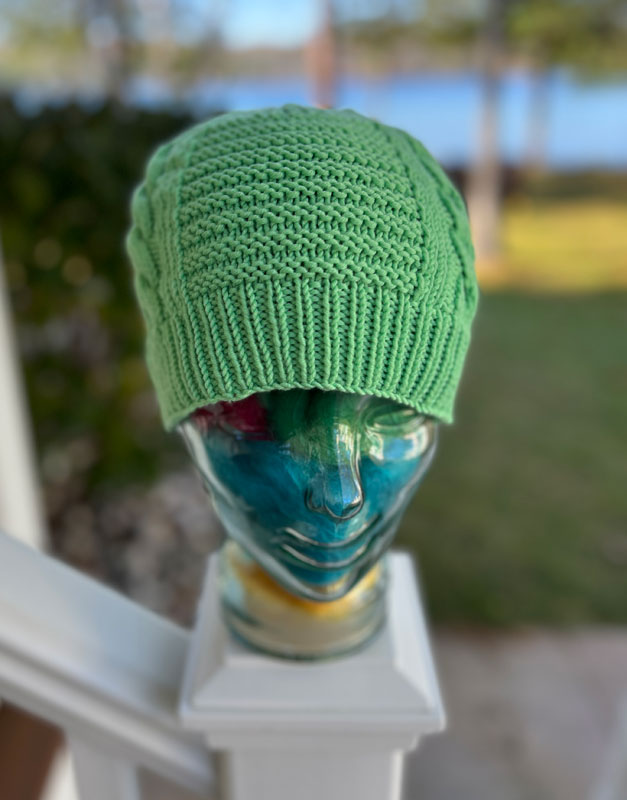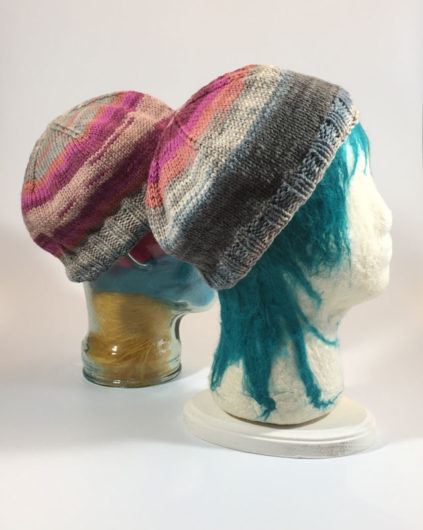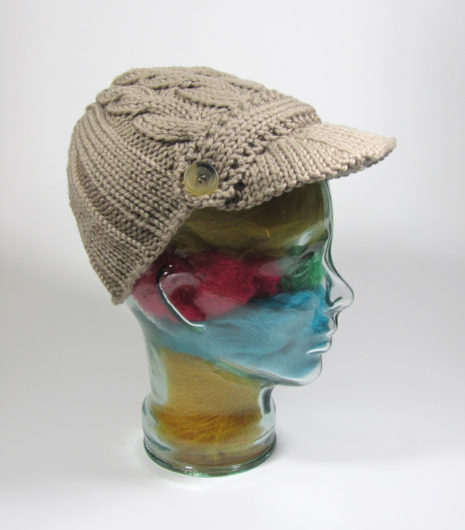
For those who follow my blog you are forgiven for thinking, “Yawn. That knitter is knitting the Thinker hat again.” I am. I definitely am. This hat is wonderful one. It fits well. It’s fun to knit. It’s a quick knit. The Thinker is a fits-all-head-sizes great hat! Check out The Thinker by Susan Villas Lewis. For $6 US you’ll have a hat pattern that works from newborn to extra large adult.
This is the (ahem) 12th time I’ve knit The Thinker. And I’m thinking about knitting it again soon!

This time I used a wonderful but sadly discontinued yarn by Sugar Bush Yarns: Bold. It was an excellent superwash merino worsted and I was disappointed to see it bite the dust. That’s true even though I managed to snag a boatload of skeins at a great price at WEBS a good while back.
I make a few modifications in the pattern to make it even more perfect (to my way of thinking). I knit the ribbing on US 5’s and the body on 7’s instead of knitting the entire hat in the same needle size. And after the ribbing I knit one round plain before starting the body of the hat. I also knit one round before starting the second section of ribbing, after the main body of the hat. Those extra rounds create an attractive transitional “furrow” that I like. Totally knitter’s choice on that. The largest size ends after half a section of the garter stitch, after what amounts to a round 9. I knit a round 10 before transitioning into the ribbing.

Even a super organized crown decrease!
Next up is Christine Kelly’s Mutze, actually it’s Mutze with an umlaut above the “u.” But this keyboard dummy can’t figure out how to type an umlaut so umlautless Mutze will have to do. I knit my Mutze in Berroco Lanas, a wool worsted.

My only modification was to work the crown decreases only until I got the stitch count down to 12. I feared that following the pattern exactly with a final set of decreases would result in the dreaded pointy-hat-syndrome. ‘Tis a condition to be avoided at all costs in my knitting world. Heads don’t come to a point and hats shouldn’t either, in my view. Well, except baby hats. We can put babies’ heads in any kind of silly hat we want to. They do not care.

Mutze is a good no-nonsense hat, akin to a number of hats with this same basic construction: alternating reverse stockinette ridges with ribbing of some sort. It’s an excellent addition to the catalog.
PentaCap is next: a freebie by the very talented hat designer, Wooly Wormhead. OK. Probably her mom didn’t name her Wooly and her birth certificate doesn’t say her surname is Wormhead. But she goes to great lengths to keep her “real” name to herself. She goes by Wooly. And she also says that she just made up the name “Ruth Patterson” when the NY Times interviewed her on businesses like hers reacting to Brexit by shifting their companies to Estonia, though apparently just in the digital world.

I’m digressing. Nothing new in that. PentaCap is a typical Wormhead creation. Strong structural elements. Lots of great techniques to learn. I knit mine in Plymouth Yarn Worsted Merino Superwash Solid. It’s a tad pricey. But there’s a lot of bang for the buck. And when someone throws the hat in the washer and then in the dryer all will be well.
I used the suggested crochet cast-on. You work it just like a provisional crochet cast-on except that instead of working with a contrasting yarn, you work with the main color. And you don’t unravel it to work in the “other” direction. You simply enjoy the stretchiness and how nicely it frames the hat.
At the end of the garter stitch section comes a “bind off braid.” That’s what creates the interesting raised ridge before the stockinette section begins. For me it’s a new tool for the toolbox. Here’s the link to the designer’s tutorial on how to work a “bind-off braid.”

And PentaCap has a nice swirly, well-behaved crown.
It’s warm here in Michigan. Not Phoenix or Miami warm. Breathing in deeply doesn’t sear your lungs. And if you stumble to the sidewalk you won’t end up in the burn unit. (That weather is nothing to joke about and I won’t.)
But, anyway, it’s warm for here. These are the dog days of summer, after all: 20 days before and 20 days after the dog star Sirius rises and falls in conjunction with the sun. In case you don’t have your star charts handy, that’s from about July 3rd to about August 11th. I always enjoy knitting hats during the dog days. Hats are small projects. They don’t create a lot of heat in your lap. So consider knitting a hat! Pretty soon heads in your neck of the woods will be needing them.
















































